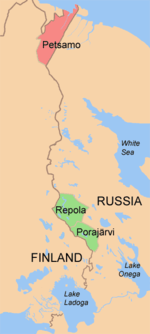Treaty of Tartu (Russian–Finnish)
| Russian: Тартуский мирный договор Finnish: Tarton rauha | |
|---|---|
|
| |
| Type | Peace treaty |
| Signed | 14 October 1920 |
| Location | Tartu, Estonia |
| Effective | 31 December 1920 (according to article 39 of the treaty) |
| Expiration |
1939 Start of Winter War |
| Signatories |
|
| Language |
Russian Finnish Swedish |
The Treaty of Tartu (Russian: Тартуский мирный договор, Finnish: Tarton rauha) between Finland and Soviet Russia was signed on 14 October 1920 after negotiations that lasted four months. The treaty confirmed the border between Finland and Soviet Russia after the Finnish civil war and Finnish volunteer expeditions in Russian East Karelia.
Treaty was signed in Tartu (Estonia) at the Estonian Students' Society building. Ratifications of the treaty were exchanged in Moscow on 31 December 1920. The treaty was registered in the League of Nations Treaty Series on 5 March 1921.[1]
The treaty confirmed that the Finnish-Soviet border would follow the old border between the autonomous Grand Duchy of Finland and Imperial Russia. Finland additionally received Petsamo, with its ice-free harbour on the Arctic Ocean. As far back as 1864, Tsar Alexander II had promised to join Petsamo to Finland in exchange for a piece of the Karelian Isthmus.[2] Finland also agreed to leave the joined and then occupied areas of Repola (joined to Finland during the Viena expedition) and Porajärvi (joined during the Aunus expedition) in Russian East Karelia. The treaty also had some articles besides area and border issues, including Soviet guarantee of free navigation of merchant ships from the Finnish ports in Lake Ladoga (Laatokka in Finnish) to the Gulf of Finland via the River Neva. Finland guaranteed land transit from the Soviet Union to Norway via the Petsamo area. Also, Finland agreed to disarm the coastal fortress in Ino, opposite the Soviet city Kronstadt located on the island of Kotlin. The Finnish outer islands in the Gulf of Finland were demilitarized.
The treaty was subject to controversy first during the East Karelian Uprising 1921–1922 when the Finnish government allowed volunteers to take part in the conflict, and was finally broken by the Soviet Union in 1939 when it started the Winter War.
Delegations
The Finnish delegation
- Juho Kusti Paasikivi, leader
- Juho Vennola
- Alexander Frey
- Rudolf Walden
- Väinö Tanner
- Väinö Voionmaa
- Väinö Kivilinna
it is related with
Soviet Delegation
- Janis Berzins (Berzin-Ziemelis)
- Platon Mikhailovich Kerzhentsev
- Nikolai Sergeyevich Tikhmenev
- Aleksandr Aleksandrovich Samoylo
- Yevgeny Andreyevich Berens
Notes
- ↑ League of Nations Treaty Series, vol. 3, pp. 6–79
- ↑ Pieni tietosanakirja, "The senate had suggested in 1863 that if the promise of handing over the weapons factory in question and its surrounding area to Russia could be realized, then the above mentioned coastal region could be given to Finland. In 1864 there were imperial statutes about that, but that never occurred." (translation from Finnish)
See also
- List of Finnish treaties
- Treaty of Tartu (Russian–Estonian)
- Soviet–Lithuanian Peace Treaty
- Latvian–Soviet Peace Treaty
External links
| Wikimedia Commons has media related to Treaty of Tartu (Russian–Finnish). |
